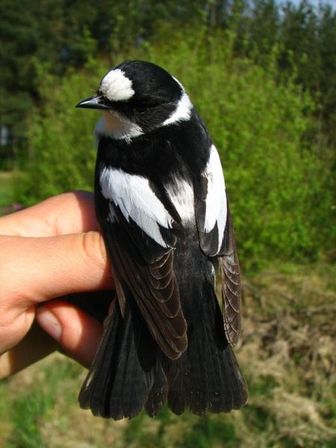Collared Flycatcher
This is a 12-13.5 cm long bird. The breeding male is mainly black above and white below, with a white collar, large white wing patch, black tail and a large white forehead patch. It has a pale rump. The bill is black and has the broad but pointed shape typical of aerial insectivores. As well as taking insects in flight, this species hunts caterpillars amongst the oak foliage, and will take berries.

Original source: http://www.akbalt.strony.univ.gda.pl
Author: Katarzyna StępniewskaThe permission for use of this work has been archived in the Wikimedia OTRS system.It is available as ticket #2011010410016346 for users with an OTRS account. If you wish to reuse this work elsewhere, please read the instructions at COM:REUSE. If you are a Commons user and wish to confirm the permission, please leave a note at the OTRS noticeboard.Ticket link: https://ticket.wikimedia.org/otrs/index.pl?Action=AgentTicketZoom&TicketNumber=2011010410016346
The Collared Flycatcher is classified as Least Concern. Does not qualify for a more at risk category. Widespread and abundant taxa are included in this category.
Of all female collared flycatchers (N = 2733) used in our analyses, 4.1% were classified as primary and 4.1% as secondary. Primary females bred on average 2.2 days earlier than monogamous females and 6.2 days earlier than secondary females (Table 1). Clutch size did not differ with respect to mating status once the decline in clutch size due to laying date was accounted for (Table 1). More
Collared Flycatcher Ficedula albicollis is a rather common breeding bird of deciduous woods in central Europe (Czech Republic, Slovakia, Poland, Hungary, etc) from late April through summer. Breeding plumage males have more white on them than their close relatives Pied Flycatcher F. hypoleuca and Semi-collared Flycatcher F. semitorquata, especially on the forehead, wing and nape, hence the albicollis "white collar" in the name. Females and juveniles are very similar to the juveniles and females of those species. More
On Gotland, the Collared Flycatcher is approximately 10 times as abundant as the Pied Flycatcher. The two species hybridize (4% of all matings) at frequencies less than those predicted for random mating (13%). Mixed pairs produce as many offspring as pure Pied Flycatcher pairs and more offspring than Collared Flycatchers. The competence at courtship and/or viability of hybrid offspring, however, is probably reduced, because fewer hybrids breed than would be expected from the proportion of hybrid fledglings. More
The Collared Flycatcher, Ficedula albicollis, is a small passerine bird in the Old World flycatcher family, one of the four species of Western Palearctic black-and-white flycatchers. It breeds in southeast Europe (isolated populations in the islands of Gotland and Oland in the Baltic Sea, Sweden) and southwest Asia and is migratory, wintering in sub Sahara Africa. It is a rare vagrant in western Europe. This is a 12-13.5 cm long bird. More
collared flycatchers is a perfect system for studying age-related changes in the wild, as the exact age and reproductive history of most individuals is known. Collared flycat.... By Sendecka Joanna-Uppsala University, Interfaculty Units, Acta Universitatis Upsaliensis-doctoral-2007-04-04 Natural and Sexual Selection in a Natural Hybrid Zone of Ficedula Flycatchers Speciation can be viewed as the formation of reproductive barriers between different populations. More
Collared Flycatcher (Ficedula albicollis) male in breeding plumage - but I needed better views to be sure and at least one photo for the record. In the end I got 3 ID-able photos showing the distinct features of the species including a 'patch' of white on the lower down the primaries, full wide and white collar. The rump was whitish. To say I was pleased no end is an understatement. More
Collared Flycatcher (Ficedula albicollis) is a rare species with some five annual records in the whole country. So, one is expecting a flycatcher to be a Pied. While extracting the bird from the net, however, I noted above a greyish tone unfamiliar to Pied Flycatcher, particularly on the sides of the neck, and a large white patch on bases of primaries. More
Collared Flycatcher Ficedula albicollis = * Home Expand Log in Menu item Register Menu item Log out Menu item Change login details Menu item Why register? Expand UK & Ireland Menu item Birding sites More
the collared flycatcher, an important "ecological model" for studies of life-history evolution, sexual selection, speciation, and quantitative genetics. A pedigree of 322 birds from a natural population was genotyped for 384 single nucleotide polymorphisms (SNPs) from 170 protein-coding genes and 71 microsatellites. Altogether, 147 gene markers and 64 microsatellites form 33 linkage groups with a total genetic distance of 1787 cM. Male recombination rates are, on average, 22% higher than female rates (total distance 1982 vs. 1627 cM). More
Newly arrived Collared flycatcher male on breeding grounds on Gotland ( More
Z-linked and autosomal loci in pied and collared flycatchers that have been living in allopatry. We used pied flycatchers from Spain and collared flycatchers from Italy, which according to mtDNA divergence and a standard clock separated ~2 million years ago (Saetre et al. 2001). More
Passeriformes >> Collared Flycatcher - Ficedula albicollis tree view | thumbnails | slideshow Collared Flycatcher - Ficedula albicollis - Collared Flycatcher - Ficedula albicollis Collared Flycatcher - Ficedula albicollis Collared Flycatcher - Ficedula albicollis Collared Flycatcher - Ficedula albicollis Collared Flycatcher - Ficedula albicollis Collared Flycatcher - Ficedula albicollis Collared Flycatcher - Ficedula albicollis Collared Flycatcher - Ficedula albicollis post a comment More
• Collared Flycatcher Photos on Surfbirds • ID Discussion Forum • ID Discussion Photo Gallery • More Advanced ID Articles Interviews Keep Browsing Books One (or indeed two) of the highlights of birding in the UK in Spring 2009 was the presence of two male Collared Flycatchers – at Portland (April) and Fife (May). More

Original source: Emijrpbot
Author: Emijrpbot
Permission: Some rights reserved
Family : Muscicapidae
Genus : Ficedula
Species : albicollis
Authority : (Temminck, 1815)

